Properties and Structure of Concretes Doped with Production Waste of Thermoplastic Elastomers from the Production of Car Floor Mats
Abstract
1. Introduction
2. Materials and Methods
2.1. Materials
2.2. Methods
3. Results and Discussion
4. Conclusions
Author Contributions
Funding
Data Availability Statement
Acknowledgments
Conflicts of Interest
References
- Kishore, K.; Gupta, N. Application of domestic & industrial waste materials in concrete: A review. Mater. Today Proc. 2020, 26, 2926–2931. [Google Scholar] [CrossRef]
- Aggarwal, Y.; Siddique, R. Microstructure and properties of concrete using bottom ash and waste foundry sand as partial replacement of fine aggregates. Constr. Build. Mater. 2014, 54, 210–223. [Google Scholar] [CrossRef]
- Halicka, A.; Ogrodnik, P.; Zegardlo, B. Using ceramic sanitary ware waste as concrete aggregate. Constr. Build. Mater. 2013, 48, 295–305. [Google Scholar] [CrossRef]
- Ulewicz, M.; Halbiniak, J. Application of waste from utilitarian ceramics for production of cement mortar and concrete. Physicochem. Probl. Miner. Process. 2016, 52, 1002–1010. [Google Scholar]
- Walczak, P.; Małolepszy, J.; Reben, M.; Rzepa, K. Mechanical properties of concrete mortar based on mixture of CRT glass cullet and fluidized fly ash. Procedia Eng. 2015, 108, 453–458. [Google Scholar] [CrossRef]
- Bostanci, S.C.; Limbachiya, M.; Kew, H. Portland-composite and composite cement concretes made with coarse recycled and recycled glass sand aggregates: Engineering and durability properties. Constr. Build. Mater. 2016, 128, 324–340. [Google Scholar] [CrossRef]
- Choi, S.-J.; Kim, Y.-U.; Oh, T.-G.; Cho, B.-S. Compressive Strength, Chloride Ion Penetrability, and Carbonation Characteristic of Concrete with Mixed Slag Aggregate. Materials 2020, 13, 940. [Google Scholar] [CrossRef]
- Gu, L.; Ozbakkaloglu, T. Use of recycled plastics in concrete: A critical review. Waste Manag. 2016, 51, 19–42. [Google Scholar] [CrossRef]
- Rashad, A.M. A comprehensive overview about recycling rubber as fine aggregate replacement in traditional cementitious materials. Int. J. Sustain. Built Environ. 2016, 5, 46–82. [Google Scholar] [CrossRef]
- Tavakoli, D.; Hashempour, M.; Heidari, A. Use of Waste Materials in Concrete: A review. Pertanika J. Sci. Technol. 2018, 26, 499–522. [Google Scholar]
- Sharma, R.; Bansal, P.P. Use of different forms of waste plastic in concrete—A review. J. Clean. Prod. 2016, 112, 473–482. [Google Scholar] [CrossRef]
- Choi, Y.W.; Moon, D.J.; Chung, J.S.; Cho, S.K. Effects of waste PET bottlers aggregate on the properties of concrete. Cem. Concr. Res. 2005, 35, 776–781. [Google Scholar] [CrossRef]
- Choi, Y.W.; Moon, D.J.; Kim, Y.J.; Lachemi, M. Characteristics of mortar and concrete containing fine aggregate manufactured from recycled waste polyethylene terephthalate bottles. Constr. Build. Mater. 2009, 23, 2829–2835. [Google Scholar] [CrossRef]
- Nibudey, R.; Nagarnaik, P.; Parbat, D.; Pande, A. Strength and fracture properties of post consumed waste plastic fiber reinforced concrete. Int. J. Civ. Struct. Environ. Infrastruct. Eng. Res. Dev. 2013, 3, 9–16. [Google Scholar]
- Rahmani, E.; Dehestani, M.; Beygi, M.H.A.; Allahyari, H.; Nikbin, I.M. On the mechanical properties of concrete contain-ing waste PET particles. Constr. Build. Mater. 2013, 47, 1302–1308. [Google Scholar] [CrossRef]
- Ferreira, L.; De Brito, J.; Saikia, N. Influence of curing conditions on the mechanical performance of concrete containing recycled plastic aggregate. Constr. Build. Mater. 2012, 36, 196–204. [Google Scholar] [CrossRef]
- Silva, R.; De Brito, J.; Saikia, N. Influence of curing conditions on the durability-related performance of concrete made with selected plastic waste aggregates. Cem. Concr. Compos. 2013, 35, 23–31. [Google Scholar] [CrossRef]
- Saikia, N.; de Brito, J. Waste polyethylene terephthalate as an aggregate in concrete. Mater. Res. 2013, 16, 341–350. [Google Scholar] [CrossRef]
- Ochi, T.; Okubo, S.; Fukui, K. Development of recycled PET fiber and its application as con-crete-reinforcing fiber. Cement Concr. Compos. 2007, 29, 448–455. [Google Scholar] [CrossRef]
- Chaudhary, M.; Srivastava, V.; Agarwal, V. Effect of waste low density polyethylene on mechanical properties of concrete. J. Acad. Ind. Res. 2014, 3, 123. [Google Scholar]
- Martínez-Barrera, G.; Vigueras-Santiago, E.; Hernández-López, S.; Brostow, W.; Menchaca-Campos, C. Me-chanical improvement of concrete by irradiated polypropylene fibers. Polym. Eng. Sci. 2005, 45, 1426–1431. [Google Scholar] [CrossRef]
- Abdelmoti, H.; Mustafa, A.M. Use of Polypropylene Waste Plastic Pellets as Partial Replacement for Fine Aggregate in Concrete. Univ. Khartoum Eng. J. 2019, 9, 37–43. [Google Scholar]
- Wang, Y.; Wu, H.; Li, V.C. Concrete reinforcement with recycled fibers. J. Mater. Civ. Eng. 2000, 12, 314–319. [Google Scholar] [CrossRef]
- Borovanska, I.; Dobreva, T.; Benavente, R.; Djoumaliisky, S.; Kotzev, G. Quality assessment of recycled and modified LDPE/PP blends. J. Elastomers Plast. 2012, 44, 479–497. [Google Scholar] [CrossRef]
- Kojnoková, T.; Markovičová, L.; Nový, F. The changes of LD-PE films after exposure in different media. Prod. Eng. Arch. 2020, 26, 185–189. [Google Scholar] [CrossRef]
- Kakooei, S.; Akil, H.M.; Jamshidi, M.; Rouhi, J. The effects of polypropylene fibers on the properties of reinforced concrete structures. Constr. Build. Mater. 2012, 27, 73–77. [Google Scholar] [CrossRef]
- Sivakumar, A.; Santhanam, M. A quantitative study on the plastic shrinkage cracking in high strength hybrid fibre reinforced concrete. Cem. Concr. Compos. 2007, 29, 575–581. [Google Scholar] [CrossRef]
- Pietrzak, A.; Ulewicz, M. The impact of the length of polypropylene fibers on selected properties of concrete. Acta Sci. Pol. Arch. Bud. 2019, 18, 21–25. [Google Scholar] [CrossRef]
- Tang, W.; Lo, Y.; Nadeem, A. Mechanical and drying shrinkage properties of structural-graded polystyrene aggregate con-crete. Cem. Concr. Compos. 2008, 30, 403–409. [Google Scholar] [CrossRef]
- Herki, A.; Khatib, J.; Negim, E. Lightweight concrete made from waste polystyrene and fly ash. World Appl. Sci. J. 2013, 21, 1356–1360. [Google Scholar]
- Babu, D.S.; Babu, K.G.; Tiong-Huan, W. Effect of polystyrene aggregate size on strength and moisture migration characteristics of lightweight concrete. Cem. Concr. Compos. 2006, 28, 520–527. [Google Scholar] [CrossRef]
- Xu, Y.; Jiang, L.; Xu, J.; Li, Y. Mechanical properties of expanded polystyrene lightweight aggregate concrete and brick. Constr. Build. Mater. 2012, 27, 32–38. [Google Scholar] [CrossRef]
- Sofi, A. Effect of waste tyre rubber on mechanical and durability properties of concrete—A review. Ain Shams Eng. J. 2018, 9, 2691–2700. [Google Scholar] [CrossRef]
- Balaha, M.M.; Badawy, A.A.M.; Hashish, M. Effect of using ground tire rubber as fine aggregate on the behaviour of concrete mixes. Indian J. Eng. Mater. Sci. 2007, 14, 427–435. [Google Scholar]
- Gesoğlu, M.; Güneyisi, E. Strength development and chloride penetration in rubberized concretes with and without silica fume. Mater. Struct. 2007, 40, 953–964. [Google Scholar] [CrossRef]
- Albano, C.; Camacho, N.; Reyes, J.; Feliu, J.L.; Herna´ndez, M. Influence of scrap rubber to Portland I concrete composites: Destructive and non-destructive testing. Compos. Struct. 2005, 71, 439–446. [Google Scholar] [CrossRef]
- Holmes, N.; Dunne, K.; O’Donnell, J. Longitudinal shear resistance of composite slabs containing crumb rubber in concrete toppings. Constr. Build. Mater. 2014, 55, 365–378. [Google Scholar] [CrossRef]
- Bravo, M.; de Brito, J. Concrete made with used tyre aggregate: Durability-related performance. J. Clean. Prod. 2012, 25, 42–50. [Google Scholar] [CrossRef]
- Onuaguluchi, O.; Panesar, D.K. Hardened properties of concrete mixtures containing pre-coated crumb rubber and silica fume. J. Clean. Prod. 2014, 82, 125–131. [Google Scholar] [CrossRef]
- Taha, M.M.R.; El-Dieb, A.S.; El-Wahab, M.A.A.; Abdel-Hameed, M.E. Mechanical, fracture, and microstructural investigations of rubber concrete. J. Mater. Civ. Eng. 2008, 20, 640–649. [Google Scholar] [CrossRef]
- Batayneh, M.K.; Marie, I.; Asi, I. Promoting the use of crumb rubber concrete in developing countries. Waste Manag. 2008, 28, 2171–2176. [Google Scholar] [CrossRef]
- Lavagna, L.; Nisticò, R.; Sarasso, M.; Pavese, M. An Analytical Mini-review on the compression strength of rubberized concrete as a function of the amount of recycled tires crumb rubber. Materials 2020, 13, 1234. [Google Scholar] [CrossRef]
- Mercante, I.; Alejandrino, C.; Ojeda, J.P.; Chini, J.; Maroto, C.; Fajardo, N. Mortar and concrete composites with recycled plastic: A review. Sci. Technol. Mater. 2018, 30, 69–79. [Google Scholar] [CrossRef]
- Pelisser, F.; Zavarise, N.; Longo, T.A.; Bernardin, A.M. Concrete made with recycled tire rubber: Effect of alkaline activation and silica fume addition. J. Clean. Prod. 2011, 19, 757–763. [Google Scholar] [CrossRef]
- Ramdani, S.; Guettala, A.; Benmalek, M.L.; Aguiar, J.B. Physical and mechanical performance of concrete made with waste rubber aggregate, glass powder and silica sand powder. J. Build. Eng. 2019, 21, 302–311. [Google Scholar] [CrossRef]
- Almeida, F.; Cunha, V.M.C.F.; Miranda, T.; Cristelo, N. Indirect tensile behaviour of fibre reinforced alkali-activated composites. Fibers 2018, 6, 30. [Google Scholar] [CrossRef]
- Kytinou, V.K.; Chalioris, C.E.; Karayannis, C.G. Analysis of residual flexural stiffness of steel fiber-reinforced concrete beams with steel reinforcement. Materials 2020, 13, 2698. [Google Scholar] [CrossRef]
- Babaie, R.; Abolfazli, M.; Fahimifar, A. Mechanical properties of steel and polymer fiber reinforced concrete. J. Mech. Behav. Mater. 2019, 28, 119–134. [Google Scholar] [CrossRef]
- Commission Decision of amending Decision 2000/532/EC on the list of waste pursuant to Directive 2008/98/EC of the European Parliament and of the Council (2014/955/EU). European Parliament, Brussels. Available online: https://eur-lex.europa.eu/legal-content/EN/TXT/?uri=CELEX%3A32014D0955 (accessed on 11 February 2021).
- The Polish Committee for Standardization. Specification of Sampling, Testing and Evaluation of the Suitability of Mixing Water for Concrete, Including Water Recovered from Concrete Production Processes; The Polish Committee for Standardization: Warsaw, Poland, July 2002. [Google Scholar]
- The Polish Committee for Standardization: PN-EN 12350-2:2011. Testing Fresh Concrete—Part 2: Slump-Test; The Polish Committee for Standardization: Warsaw, Poland, 2011. [Google Scholar]
- The Polish Committee for Standardization: PN-EN 12350-7:2011. Testing Fresh Concrete—Part 7: Air Content—Pressure methods; The Polish Committee for Standardization: Warsaw, Poland, 2011. [Google Scholar]
- The Polish Committee for Standardization: PN-EN 206-1+A1:2016-12. Concrete—Requirements, Properties, Production and Compliance; The Polish Committee for Standardization: Warsaw, Poland, 2016. [Google Scholar]
- The Polish Committee for Standardization: PN-EN 12390-1:2013-03. Testing Hardened Concrete—Part 1: Shape, Dimensions and other Requirements for Specimens and Moulds; The Polish Committee for Standardization: Warsaw, Poland, 2013. [Google Scholar]
- The Polish Committee for Standardization: PN-EN 12390-2:2019-07. Testing Hardened Concrete—Part 2: Making and Curing Specimens for Strength Tests; The Polish Committee for Standardization: Warsaw, Poland, 2019. [Google Scholar]
- The Polish Committee for Standardization: PN-EN 12390-3:2019-07. Testing Hardened Concrete—Part 3: Compressive Strength of Test Specimens; The Polish Committee for Standardization: Warsaw, Poland, 2019. [Google Scholar]
- The Polish Committee for Standardization: PN-EN 12390-4:2001. Testing Hardened Concrete—Part 4: Compressive Strength—Requirements for Testing Machines; The Polish Committee for Standardization: Warsaw, Poland, 2001. [Google Scholar]
- The Polish Committee for Standardization: PN-EN 12390-5:2019-08. Testing Hardened Concrete—Part 5: Bending Strength of Test Specimens; The Polish Committee for Standardization: Warsaw, Poland, 2019. [Google Scholar]
- The Polish Committee for Standardization: PN-EN 12390-6:2011. Testing Hardened Concrete—Part 6: Tensile Strength when Splitting Test Samples; The Polish Committee for Standardization: Warsaw, Poland, 2011. [Google Scholar]
- The Polish Committee for Standardization: PN-B 06250. Plain Concrete; The Polish Committee for Standardization: Warsaw, Poland, 2003. [Google Scholar]
- The Polish Committee for Standardization: PN-EN 12390-8:2019-08. Testing Hardened Concrete—Part 8: The Depth of Penetration of Pressurized Water; The Polish Committee for Standardization: Warsaw, Poland, 2019. [Google Scholar]
- The Polish Committee for Standardization: PN-EN 13892-3:2015. Methods of Testing Materials for Floor Screeds—Part 3: Determination of The Resistance to Abrasion According to Boehme; The Polish Committee for Standardization: Warsaw, Poland, 2015. [Google Scholar]
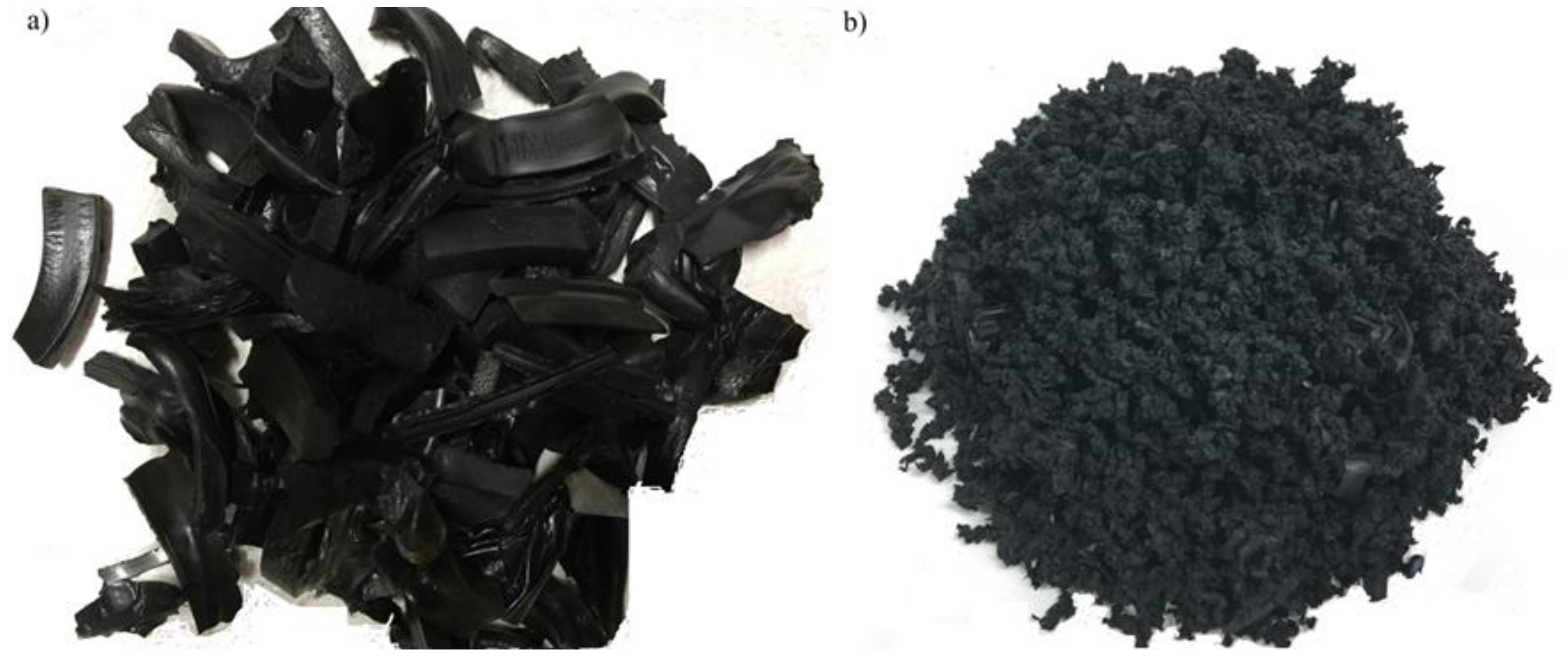
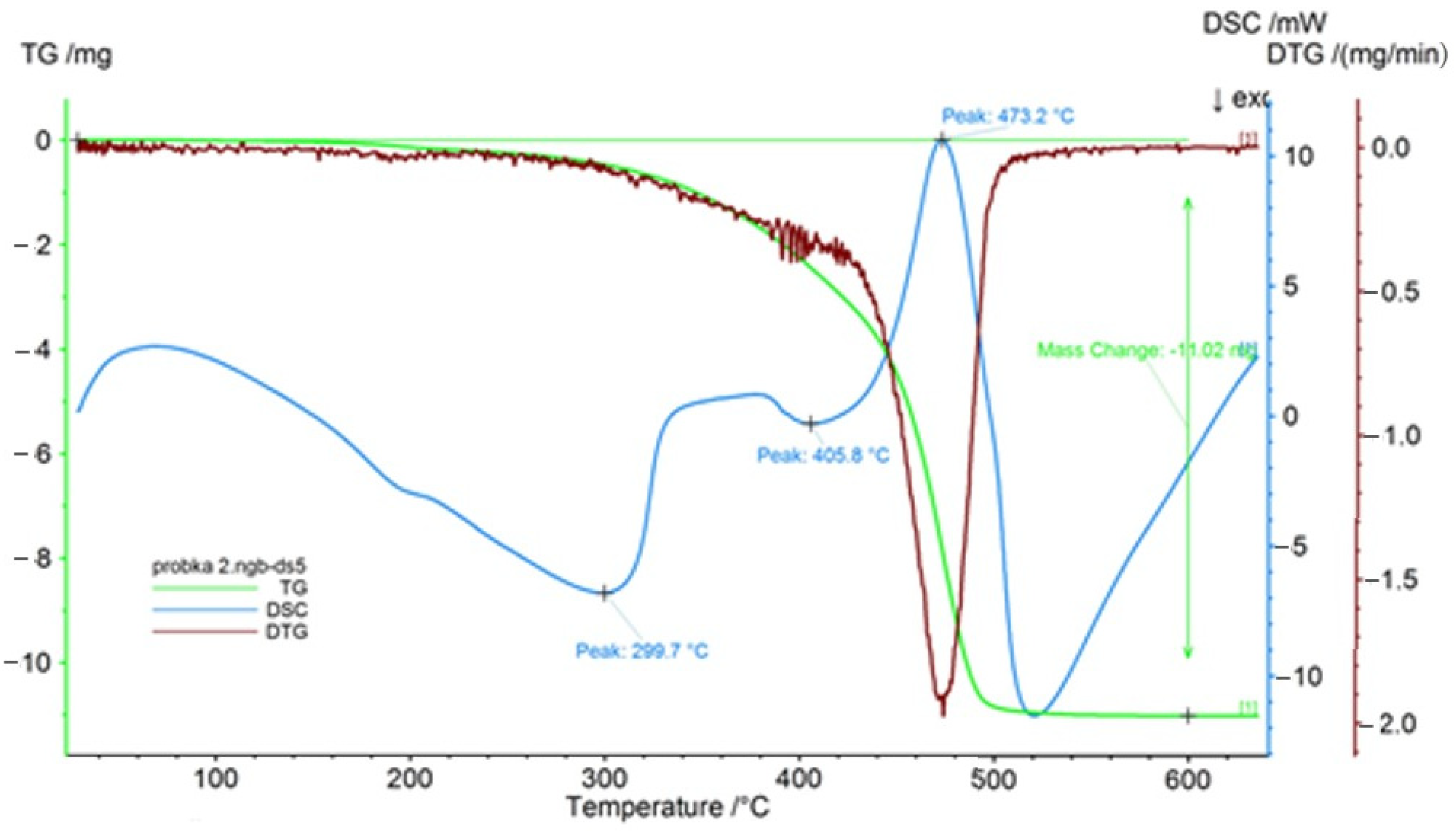
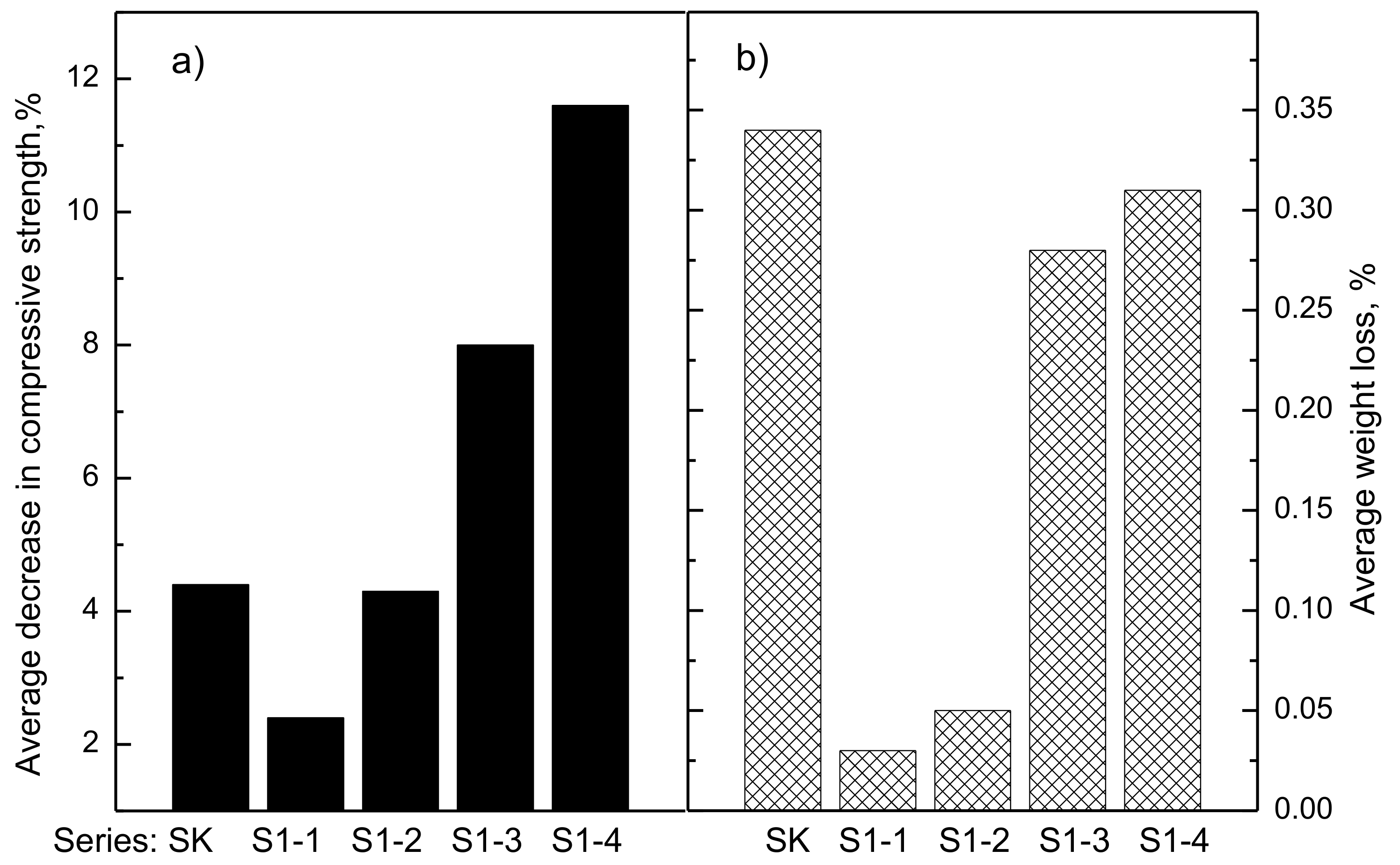
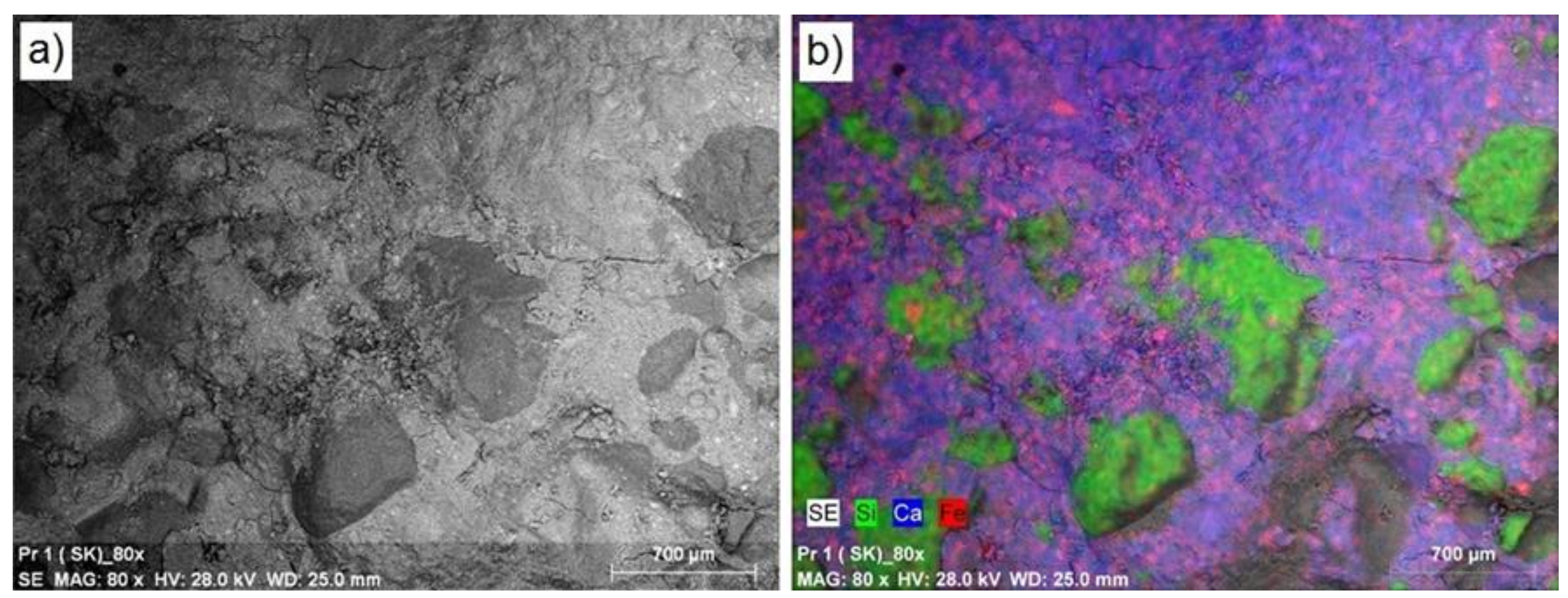
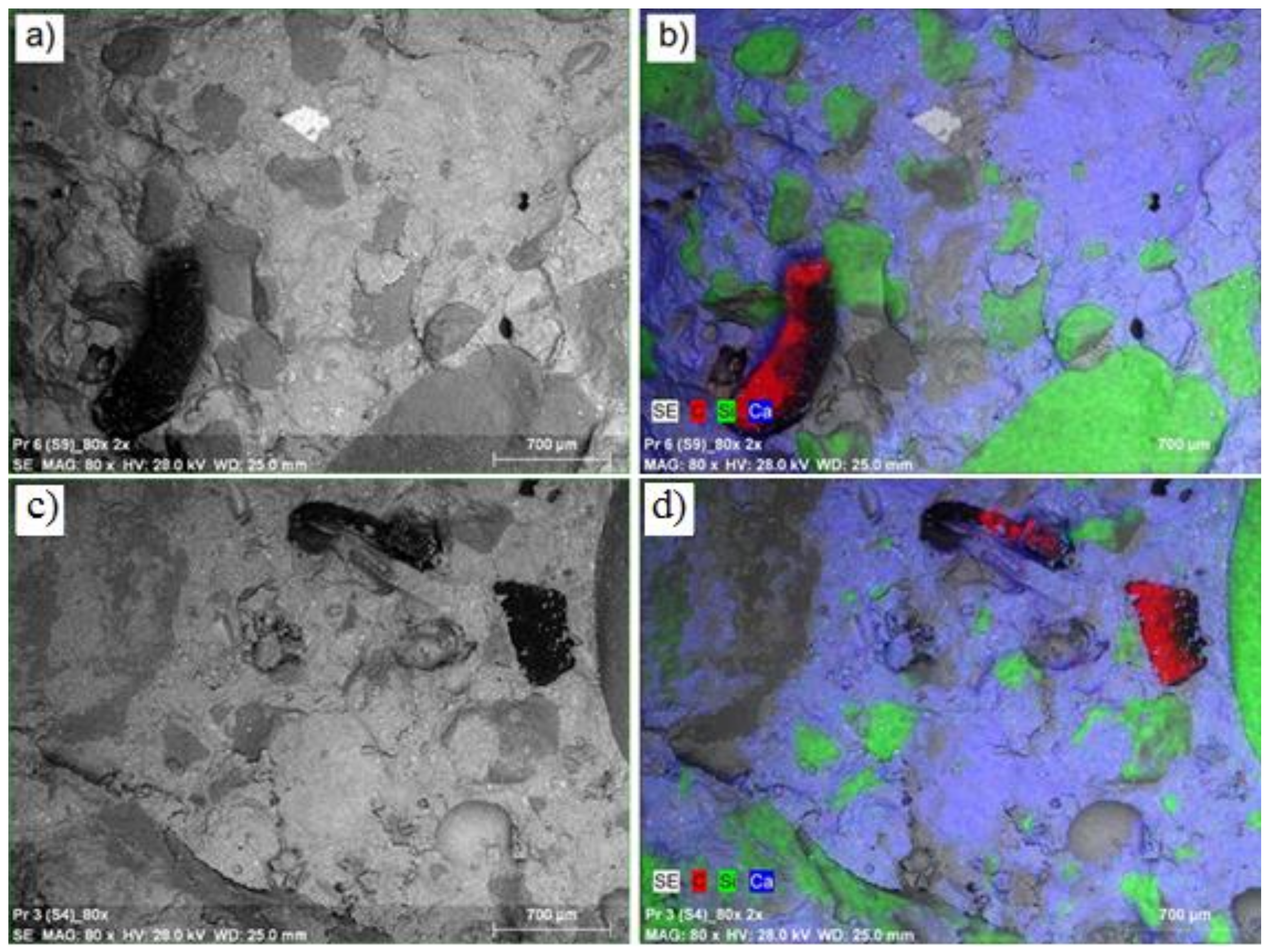
| Chemical Composition [% (m/m)] | ||||||||
|---|---|---|---|---|---|---|---|---|
| Ca | Si | Al | Zn | Mg | S | Ti | Fe | K |
| 2.20 | 0.49 | 0.28 | 0.51 | 0.10 | 0.28 | 0.02 | 0.02 | 0.03 |
| Composition | Units | Series | ||||
|---|---|---|---|---|---|---|
| SK | S1-1 | S1-2 | S1-3 | S1-4 | ||
| Cement | kg/m3 | 327.50 | 327.50 | 327.50 | 327.50 | 372.5 |
| Water | dm3/m3 | 167.50 | 167.50 | 167.50 | 167.50 | 167.5 |
| Sand | kg/m3 | 463.70 | 463.70 | 463.70 | 463.70 | 463.7 |
| Gravel 8–16 | kg/m3 | 776.20 | 776.20 | 776.20 | 776.20 | 776.2 |
| Gravel 2–8 | kg/m3 | 635.10 | 593.90 | 552.80 | 511.70 | 470.5 |
| Plasticizing admixture | dm3/m3 | 1.30 | 1.30 | 1.30 | 1.30 | 1.30 |
| Air entraining admixture | dm3/m3 | 0.745 | 0.745 | 0.745 | 0.745 | 0.745 |
| Production waste | kg/m3 | − | 9.31 | 18.63 | 27.94 | 37.25 |
| Series | Consistence mm/Class | Air Content [%] |
|---|---|---|
| SK | 70/S2 | 3.50 |
| S1-1 | 55/S2 | 3.95 |
| S1-2 | 55/S2 | 3.90 |
| S1-3 | 50/S2 | 3.65 |
| S1-4 | 75/S2 | 4.10 |
| Series | Compression Strength [MPa] | Resistance Class | ||
|---|---|---|---|---|
| After 7 Days | After 28 Days | After 56 Days | ||
| SK | 46.6 | 57.0 | 61.9 | C40/50 |
| S1-1 | 46.5 | 57.8 | 62.1 | C40/50 |
| S1-2 | 44.0 | 51.5 | 54.9 | C35/45 |
| S1-3 | 42.9 | 50.1 | 53.0 | C35/45 |
| S1-4 | 36.1 | 44.1 | 46.8 | C30/37 |
| Series | Bending Strength [MPa] | Splitting Tensile Strength [MPa] |
|---|---|---|
| SK | 3.59 | 3.78 |
| S1-1 | 3.70 | 4.29 |
| S1-2 | 3.67 | 4.12 |
| S1-3 | 3.56 | 3.58 |
| S1-4 | 3.44 | 3.32 |
| Series | Water Absorbability [%] | Density [kg/m3] | Water Penetration [mm] | Abrasion Strength [cm2/50 cm2] |
|---|---|---|---|---|
| SK | 5.4 | 2271 | 65 | 7.4 |
| S1-1 | 5.2 | 2258 | 60 | 6.9 |
| S1-2 | 5.6 | 2218 | 63 | 6.7 |
| S1-3 | 5.6 | 2214 | 65 | 7.0 |
| S1-4 | 5.3 | 2172 | 67 | 7.2 |
Publisher’s Note: MDPI stays neutral with regard to jurisdictional claims in published maps and institutional affiliations. |
© 2021 by the authors. Licensee MDPI, Basel, Switzerland. This article is an open access article distributed under the terms and conditions of the Creative Commons Attribution (CC BY) license (http://creativecommons.org/licenses/by/4.0/).
Share and Cite
Ulewicz, M.; Pietrzak, A. Properties and Structure of Concretes Doped with Production Waste of Thermoplastic Elastomers from the Production of Car Floor Mats. Materials 2021, 14, 872. https://doi.org/10.3390/ma14040872
Ulewicz M, Pietrzak A. Properties and Structure of Concretes Doped with Production Waste of Thermoplastic Elastomers from the Production of Car Floor Mats. Materials. 2021; 14(4):872. https://doi.org/10.3390/ma14040872
Chicago/Turabian StyleUlewicz, Malgorzata, and Alina Pietrzak. 2021. "Properties and Structure of Concretes Doped with Production Waste of Thermoplastic Elastomers from the Production of Car Floor Mats" Materials 14, no. 4: 872. https://doi.org/10.3390/ma14040872
APA StyleUlewicz, M., & Pietrzak, A. (2021). Properties and Structure of Concretes Doped with Production Waste of Thermoplastic Elastomers from the Production of Car Floor Mats. Materials, 14(4), 872. https://doi.org/10.3390/ma14040872







